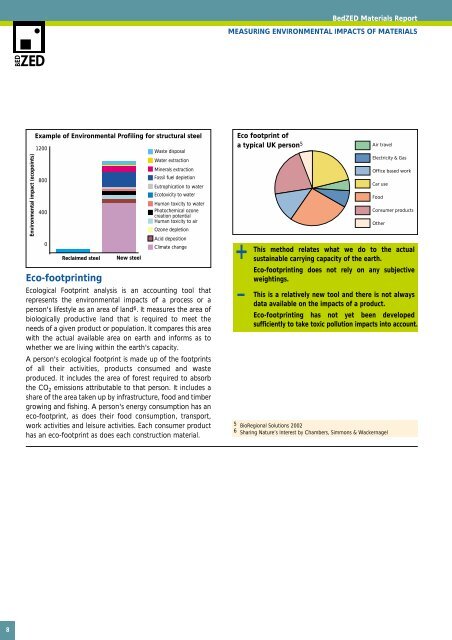Construction Materials Report - BioRegional
Construction Materials Report - BioRegional
Construction Materials Report - BioRegional
Create successful ePaper yourself
Turn your PDF publications into a flip-book with our unique Google optimized e-Paper software.
8<br />
Example of Environmental Profiling for structural steel Eco footprint of<br />
a typical UK person5 800<br />
400<br />
Environmental impact (ecopoints) 1200<br />
0<br />
Reclaimed steel New steel<br />
Eco-footprinting<br />
Waste disposal<br />
Water extraction<br />
Minerals extraction<br />
Fossil fuel depletion<br />
Eutrophication to water<br />
Ecotoxicity to water<br />
Human toxicity to water<br />
Photochemical ozone<br />
creation potential<br />
Human toxicity to air<br />
Ozone depletion<br />
Acid deposition<br />
Climate change<br />
Ecological Footprint analysis is an accounting tool that<br />
represents the environmental impacts of a process or a<br />
person's lifestyle as an area of land6. It measures the area of<br />
biologically productive land that is required to meet the<br />
needs of a given product or population. It compares this area<br />
with the actual available area on earth and informs as to<br />
whether we are living within the earth's capacity.<br />
A person's ecological footprint is made up of the footprints<br />
of all their activities, products consumed and waste<br />
produced. It includes the area of forest required to absorb<br />
the CO2 emissions attributable to that person. It includes a<br />
share of the area taken up by infrastructure, food and timber<br />
growing and fishing. A person's energy consumption has an<br />
eco-footprint, as does their food consumption, transport,<br />
work activities and leisure activities. Each consumer product<br />
has an eco-footprint as does each construction material.<br />
BedZED <strong>Materials</strong> <strong>Report</strong><br />
MEASURING ENVIRONMENTAL IMPACTS OF MATERIALS<br />
+<br />
–<br />
Air travel<br />
Electricity & Gas<br />
Office based work<br />
Car use<br />
Food<br />
Consumer products<br />
Other<br />
This method relates what we do to the actual<br />
sustainable carrying capacity of the earth.<br />
Eco-footprinting does not rely on any subjective<br />
weightings.<br />
This is a relatively new tool and there is not always<br />
data available on the impacts of a product.<br />
Eco-footprinting has not yet been developed<br />
sufficiently to take toxic pollution impacts into account.<br />
5 <strong>BioRegional</strong> Solutions 2002<br />
6 Sharing Nature’s Interest by Chambers, Simmons & Wackernagel


